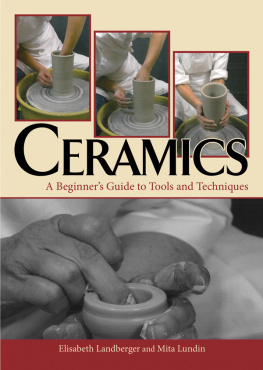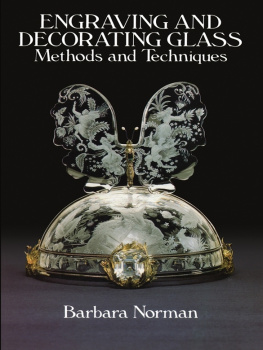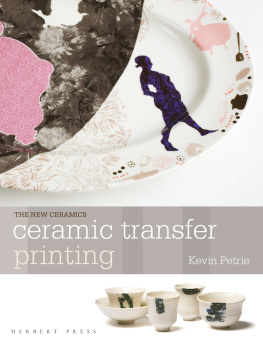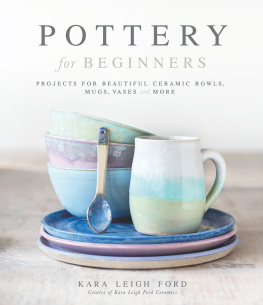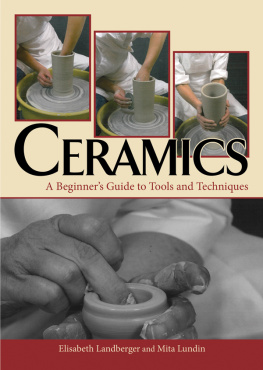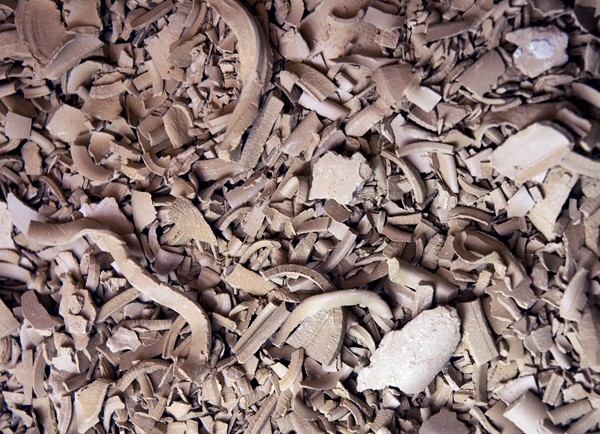Thank You To
The Form Academy in Lidkping, and especially a huge thank you to Kent Ericson who took us in with open arms and shared his knowledge and provided us with equipment.
Anders Fredholm who was very accommodating and generous with his knowledge of salt firing.
Jan-ke Andersson for his guidance and support in anagama firing.
2012 by Elisabeth Landberger and Mita Lundin
All rights reserved. Copyright under Berne Copyright Convention, Universal Copyright Convention, and Pan American Copyright Convention. No part of this book may be reproduced, stored in a retrieval system, or transmitted in any form, or by any means, electronic, mechanical, photocopying, recording, or otherwise, without the express written consent of the publisher, except in the case of brief excerpts in critical reviews or articles. All inquiries should be addressed to Allworth Press, 307 West 36th Street, 11th Floor, New York, NY 10018.
Allworth Press books may be purchased in bulk at special discounts for sales promotion, corporate gifts, fund-raising, or educational purposes. Special editions can also be created to specifications. For details, contact the Special Sales Department, Allworth Press, 307 West 36th Street, 11th Floor, New York, NY 10018 or info@skyhorsepublishing.com.
15 14 13 12 11 5 4 3 2 1
Published by Allworth Press,
an imprint of Skyhorse Publishing, Inc.
307 West 36th Street, 11th Floor, New York, NY 10018.
Allworth Press is a registered trademark of Skyhorse Publishing, Inc., a Delaware corporation.
www.allworth.com
Library of Congress Cataloging-in-Publication Data is available on file.
ISBN: 978-1-58115-896-0
Printed in China
CONTENTS
CLAY
Clay is a natural material that can be found everywhere and is formed through decomposition of igneous rocks, mainly granite. In geology this process is called weathering. The particles that make up clay are called clay particles, and are the most fine-grained weathering and erosion products.
There are two types of weathering: mechanical and chemical. Mechanical weathering occurs primarily by temperature fluctuations. Meltwater flows down into rock crevices, freezes, and expands, exposing the rock to great strain. This process gradually widens the cracks until a piece of the rock finally detaches. In this way the rock is broken down. Plants that manage to take root in the crevices may also be contributing to the detachment of mountainous parts. Chemical weathering is caused by wear and tear from weather and wind. Very small particles break away from the rock due to climate changes.
After millions of years of weathering you get a type of soil with 15 percent of its weight containing particles with a diameter of 0.002 mm. That is clay. The main components of clay are aluminum silicate (kaolinite), quartz and feldspar.
Kaolinite is a hydrous aluminum silicate, a clay mineral that is formed when rocks that contain feldspar crumble. Quartz is a mineral composed of silicon dioxide. It is the Earth's second most common mineral, after feldspar. Many varieties of quartz are popular gemstones. A few examples are: agate, rock crystal, rose and smoky quartz, onyx and amethyst. Feldspar is the generic term for several rock-forming minerals. Chemically, they contain infinite, three-dimensional, negative ions from aluminum, silicon and oxygen, where positive ions of sodium, potassium or calcium are stored.
Primary Clay and Secondary Clay
Clay can be divided into two geological categories: primary clay and secondary clay.
Primary clays are found where they were formed by the parent rock. They contain kaolin, very pure clay that is used to provide strength for porcelain and make it white. It is less plastic than secondary clay and difficult to shape because of its coarse particle size.
Secondary clay is the type of clay that has been transported away from its site of formation. Rivers, glaciers and winds transport it, and grind it up into finer particles in the process. During this process the clay gets contaminated with various pollutants, such as iron and other minerals, and various other types of organic matter. By the time the clay finally settles, often several thousand miles away from its parent rock, it has changed color, texture and thickness. The particle size of secondary clay is much finer than primary clay and therefore it has greater plasticity. It can vary vastly in color, from yellow, red, or gray to almost black.
You could say that china clay is mostly made out of primary clay, while all other clays are secondary.
MoldabilityPlasticity
The plasticity of clay has to do with its flat and hexagonal clay particles. Each particle is surrounded by water, and comparable to wet glass plates, they slide around side by side without being parted and let themselves get formed together. When the clay dries, the water disappears and the clay particles stabilize and the object retains its form.
Fat or Lean Clay
We tend to talk about fat and lean clay. Fat clay consists of small clay particles and is easy to shape. But it also has a tendency to shrink a lot, and at times even change its shape or crack during the drying or firing process. Oily clay is suitable for throwing. Lean clay is more coarse-grained and less plastic. It maintains its shape better, shrinks less and has little tendency to bruise. Therefore it is ideal for building ceramics and tiles.
You can easily change the properties of the clay by adding different substances. If the clay is too oily, you can make it thinner by adding chamotte, sand or quartz. Chamotte is burnt, crushed clay that comes in varying sizes, ranging from powders to coarse grains. If you have lean clay that you want to make more ductile and smooth, you can add ball clay or bentonite.
Different Types of Clay
Earthenware Clay
Earthenware clay is low-fired clay. Firing range varies between 1,652 and 2,192F. If you fire earthenware at higher temperatures the object will collapse and in a worst case scenario, the object will melt in the oven.
There are large quantities of earthenware clay around the world. The color ranges from gray or white to red, orange, yellow and brown. Red pottery clay is a secondary clay that is high in iron oxide, hence the red or yellow color. Blue clay is another type of clay and it contains high levels of calcium. White earthenware clay is made by mixing clays that are bright, such as ball clay and kaolin.
Earthenware clay is porous, because the clay particles have not melted completely, and the goods still absorb water, or are permeable to water, despite being fired. In order to make the pottery dense, you need to glaze it. Characteristically, pottery acquires clear and bright colors in the glaze due to the low firing temperature. Many oxides and carbonates tend to exhibit their sharpest colors at these temperatures.
Stoneware Clay
Stoneware clay contains more quartz than earthenware, and has a firing range between 2,192 and 2,372F. Most clays vitrify between these temperatures and become hard and dense. Stoneware clay is denser, because it has a higher density between the particles, and therefore it becomes heavier than earthenware clay, which is more porous. A bowl made out of stoneware is heavier than one made out of pottery clay, even if they are equal in size. The color of stoneware varies from grayish white to gray and brown. Stoneware glazes have a duller and earthier color scheme, since only a small proportion of all oxides can withstand the high temperatures.
Next page
